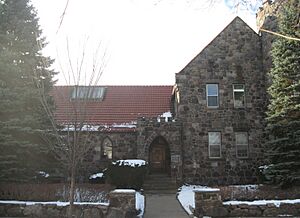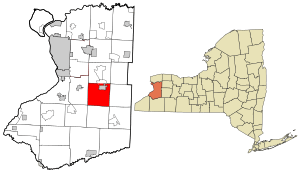Aurora, Erie County, New York facts for kids
Quick facts for kids
Aurora
|
|
|---|---|
| Town of Aurora | |

Town Hall
|
|

Location in Erie County and New York.
|
|
| Country | United States |
| State | New York |
| County | Erie County |
| Incorporated | 1818 |
| Area | |
| • Total | 36.4 sq mi (94 km2) |
| • Land | 36.4 sq mi (94 km2) |
| • Water | 0.05 sq mi (0.1 km2) |
| Elevation | 918 ft (280 m) |
| Population
(2020)
|
|
| • Total | 13,943 |
| Time zone | UTC-5 (EST) |
| • Summer (DST) | UTC-4 (EDT) |
| ZIP code |
14052
|
| Area code(s) | 716 |
Aurora is a town located in Erie County, New York, United States. It is one of the "Southtowns" in Erie County. The town is found southeast of Buffalo. In 2020, the population was 13,943 people. Sometimes, people mistakenly call it "East Aurora," which is actually the name of its main village.
Christ the King Seminary is a religious school located in the northern part of the town.
Contents
History of Aurora
The town of Aurora was created in 1818. It was formed from a much larger, older town called Willink. Willink used to cover all the southern part of Erie County.
The citizens of the area voted to change the name to "Aurora." This vote was very close. It showed that people were not happy with the Holland Land Company. This company and its owners, like Willem Willink, had a lot of control over the land.
Famous People from Aurora
Many interesting people have connections to Aurora:
- Horace Boies was the 14th Governor of Iowa.
- Millard Fillmore became a US President. Before he was president, he worked as a lawyer in Aurora. He lived in a house on Main Street, which is now a National Historic Landmark.
- Millard Powers Fillmore was the son of President Fillmore.
- Elbert Hubbard was a writer, publisher, artist, and thinker. He started a community called Roycroft in East Aurora in 1895. This community was part of the Arts and Crafts movement.
- Irving Price was one of the people who started the Fisher-Price toy company. He bought the old Fillmore home. His wife used it as a place to create art.
Geography of Aurora
The town of Aurora covers a total area of about 36.4 square miles (94.4 square kilometers). Most of this area is land. Only a very small part, about 0.05 square miles, is water.
New York State Route 240 is an important road that goes through the southwest part of the town.
Population in Aurora
| Historical population | |||
|---|---|---|---|
| Census | Pop. | %± | |
| 1820 | 1,285 | — | |
| 1830 | 2,421 | 88.4% | |
| 1840 | 2,908 | 20.1% | |
| 1850 | 3,435 | 18.1% | |
| 1860 | 2,580 | −24.9% | |
| 1870 | 2,573 | −0.3% | |
| 1880 | 2,723 | 5.8% | |
| 1890 | 3,266 | 19.9% | |
| 1900 | 4,015 | 22.9% | |
| 1910 | 4,479 | 11.6% | |
| 1920 | 5,312 | 18.6% | |
| 1930 | 6,875 | 29.4% | |
| 1940 | 7,656 | 11.4% | |
| 1950 | 9,271 | 21.1% | |
| 1960 | 12,888 | 39.0% | |
| 1970 | 14,426 | 11.9% | |
| 1980 | 13,872 | −3.8% | |
| 1990 | 13,433 | −3.2% | |
| 2000 | 13,996 | 4.2% | |
| 2010 | 13,782 | −1.5% | |
| 2020 | 13,943 | 1.2% | |
| U.S. Decennial Census | |||
In 2000, there were almost 14,000 people living in Aurora. Most of the people living in the town were White. A small percentage were African American, Native American, or Asian. About 0.59% of the population was Hispanic or Latino.
The town had 5,421 households. About 33.4% of these households had children under 18. The average age of people in Aurora was 41 years old.
Communities and Places in Aurora
Here are some of the communities and locations you can find in the town of Aurora:
- Blakeley – A small community in the southeastern part of the town.
- Cazenovia Creek (West Branch) – This is a part of Cazenovia Creek that flows north through the town.
- East Aurora – This is the main village located in the northeast part of the town.
- Griffins Mills – A community in the southwest. It is located on the West Branch of Cazenovia Creek.
- Jewettville – A place in the very southwest corner of the town, near NY-240.
- Knox Farm State Park – This is a park that was created in 2000. It used to be the large property of the Knox family.
- South Wales – A small community that is shared between Aurora and the town of Wales.
- West Falls – A community in the southwest corner of the town. It is also on the West Branch of Cazenovia Creek and NY-240.
See also
 In Spanish: Aurora (condado de Erie, Nueva York) para niños
In Spanish: Aurora (condado de Erie, Nueva York) para niños

